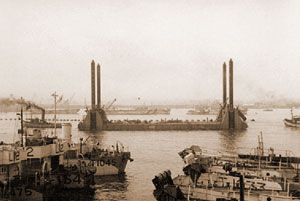Arromanches
Some details about Mulberries
Why a such project

The Mulberry harbors were conceived after «Operation Jubilee» on the French port of Dieppe, August 19. 1942. The German defence of the coast of Western Europe was built on formidable defences around ports and port facilities. As Germans claims «Who holds the Ports, holds Europe» because of the strength of these defences, the Allies had to consider other means to push large quantities of supplies across the Chanel to the D-Day beaches in the early stages of the invasion. The British solution to solve the problem was to bring their own port with them. This was an original idea of Prime Minister Winston Churchill, who already imagined a similar project during WWI for the Dardanelles Operation, in May 1943; he wrote the following note: «Piers for use on beaches. They must float up and down with the tide. The anchor problem must be mastered... Let me have the best solution worked out. Don't argue the matter. The difficulties will argue for themselves».
A brief life
All the components were constructed in secrecy in England and floated into position immediately after D-Day. Within 12 days both harbors were operational. They were intended to provide the primary means for the movement of goods from ship to shore until the port at Cherbourg was captured and opened. However, on June 19 a violent storm began, and by June 22 the American harbor had been destroyed. The British Mulberry closed on November 19.1944 after Antwerp was fully operational. Two and a half million men, half a million vehicles, and four million tons of supplies landed in Europe through the artificial harbor at Arromanches. Remains of the structure can be seen to this day.